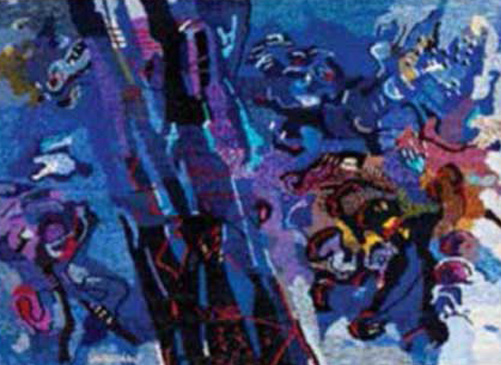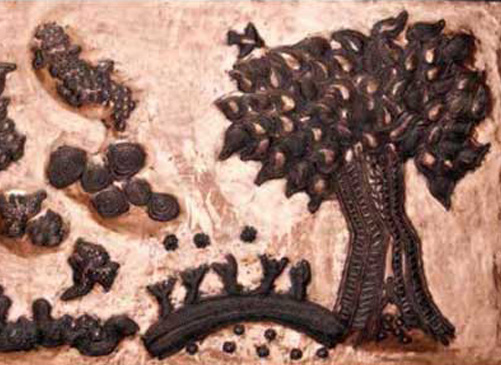EMAMICHISEL ART & RICHA AGARWAL PRESENTS
Tapestry I Relief I Painting
At Emami Art
687, Anandapur. EM Bypass Kalkata 700107 WB India
4th Nov 2016 to 4 Dec 2016
CURATOR’S NOTE
S.G.Vasudev, one of the pioneers of the Madras Art movement, which happened in 60’s, has constantly upgraded his thoughts with changing times in his art works. His updated thoughts and visualisation has made him popular among the art lovers of every age and so he has maintained his position in the arena of art consistently.
As nature enhances itself with new creations the artist also enhanced himself with his creations. And during the process of enrichment he has used different mediums. This exhibition primarily highlights his works based on different mediums and compiles his magnificent art works based on various subjects. “Kalpa Vriksha”, “Maithuna”, “Earthscape”, “Theatre of Life” have been identified time and again in his works. The colourful faces that he created once, have changed their colour to marvelous impasto on his canvases. Vasudev, being an excellent story teller, not only portrays joy on his canvas but also speaks about the pathos and loneliness of human lives. He has extended his subjects both in tapestries in silk and reliefs in copper. Marvelously sketching the shades of emotions ….love, happiness, melancholy he has made his art works very lively. We hope this outstanding exhibition of Vasudev will bring joy to the hearts of every one.
– Jyotirmoy Bhattacharya
The art and craft consciousness in early post independent India inspired many artists here to revisit traditional practises with contemporary awareness and empathy. The challenges of critically defining the implied value of continuing traditions largely centered at that time on regional consciousness and the absorption of folk and tribal symbols as well as ritualistic practises. Emerging as an artist during this period, it was natural for S.G.Vasudev to imbibe the prevalent trends, initially as a student of the Government School of Arts and Crafts, Madras, and later as a prolific artist and founder member of the Cholamandal Artists’ Village on the outskirts of the city.
The art and craft consciousness in early post independent India inspired many artists here to revisit traditional practises with contemporary awareness and empathy. The challenges of critically defining the implied value of continuing traditions largely centered at that time on regional consciousness and the absorption of folk and tribal symbols as well as ritualistic practises. Emerging as an artist during this period, it was natural for S.G.Vasudev to imbibe the prevalent trends, initially as a student of the Government School of Arts and Crafts, Madras, and later as a prolific artist and founder member of the Cholamandal Artists’ Village on the outskirts of the city.
Vasudev became known for his paintings, drawings and murals as much as for his versatility, ability to appreciate and skilfully adapt craft traditions such as copper relief and, later, tapestry as extensions of his art. His work with actual crafts – creating a range of products in batik, copper, ceramics and wood – was a separate pursuit, growing out of the Cholamandal experiment in the early days, which had artists spending a couple of hours a day on crafts as a means of earning a living at a time when the art market was virtually non- existent. His copper murals and silken tapestries are essentially artworks in different mediums and materials. The themes he explores in his paintings and drawings are also explored in copper and tapestry. In all his work, whatever the medium, the artist explores the eternal synergy between art and craft, tradition and contemporaneity, man and nature and fantasy and reality.
The art of tapestry, emerging from a multiplicity of weaving traditions across the world, generated a variety of works, most of them designed for religious or decorative purposes, while some works evolved as reproductions of paintings by renowned artists. Vasudev was inspired by the tapestries created from works by Picasso, Braque and other artists which he saw during visits to Europe.
His visit to Marc Chagall’s studio in 1980 and his interaction with the expert stained glass craftsman who had been assisting Chagall for 40 years left a lasting impression on Vasudev and motivated him to seek such an enduring association with an Indian craftsman.
Vasudev’s growing desire to render his own paintings and drawings in the medium of tapestry and his meeting with master weaver Subbarayalu in Bangalore in 1995 led to a collaborative venture in which each drew on each other’s artistic mastery and ingenuity tocreate fresh, original works of art. Vasudev’s knowledge of and respect for crafts and textiles helped in overcoming the inevitable challenges of such a long-term experiment – spanning two decades.
Handwoven imageries of select paintings were produced over the years using a stand loom to hold the warp and facilitate the interweaving of the weft of silk threads in selected colours (often specially dyed for the purpose), creating a pictorial harmony of form, texture and colour. The loom is the ground for preparing a base in warp threads stretched lengthwise while the weft of coloured threads weaves patterns that transform paintings into silken imagery. The artisan interweaves each coloured weft over portions of the warp to form the design. The individual works that result from this process are unique and symbolic of the collaborative synergy between the artist and artisan.
While paintings allow for a free flow of brushwork, tapestries require meticulous planning and great attention to technical details to achieve the required aesthetic proficiency. In his paintings, Vasudev works primarily with a single dominant colour into which other colours seep. The pictorial surface of tapestries, too, stimulates with the enticing beauty of a dominant colour that blends into a rich range of hues and accentuated lines playing with the space and texture of the imagery.
Tapestry is labour-intensive and time-consuming, with a single work taking atleast three to four weeks to be completed, depending upon the size and intricacy of the original. Vasudev appreciates the fact that Subbarayalu had specifically asked him not to try and make the process easier by selecting paintings that he thinks would be relatively simple to translate into tapestry. As he points out, the weaver’s love for and commitment to his craft were evident in his desire to take on the challenge of working on any painting, however complicated.
The complexities and beauty of the patterning can be observed on the reverse side of the art work, which reveals the counts, knots and painstaking process of tapestry. It also highlights the craftsman’s skill and the masterly way in which he handles the threads. According to Vasudev, the back of each tapestry looks totally abstract and can be as attractive as the front view. In one of his exhibitions, the entrance to the show featured the rear of a tapestry and in some others at least a few tapestries were hung so that both sides were visible.
The themes represented in the present exhibition of tapestries in silk, are familiar ones explored in Vasudev’s many series of paintings and drawings over time, such as Vriksha (Tree of Life), Maithuna (Act of Love), Humanscape, Earthscapes and Theatre of Life. Maithuna, one of his earlier themes, is symbolic of the metaphoric union between man, woman and nature. Evolving from this series is a tree that manifests as Vriksha, a rejuvenating force of nature that once again brings together a synergy of coexistence between elements of nature, with birds, animals, humans, motifs and even Kannada alphabets interacting in harmony. Humanscapes transforms the tree of life to an imagery of faces composed of leaves and other matter that in course of time evolves into ravaged layers of a tree in Earthscapes, recalling environmental degradation.
The tree of life continues to be an integral part of his later series too, including Theatre of Life wherein life is viewed as a portrayal of masked emotions, as well as the near abstract, lyrical texturing in the latest series, titled Rhapsody.
As an artist Vasudev creates his own characters and myths drawing inspiration from literature, theatre, music and other aspects of life, juxtaposed with folklore, legends and mythology. The relativity of existence can be seen as a thread of continuity unifying the works. As the artist says, ‘Whether it is man, woman, tree, sky, earth, sun, moon, all have to co-exist. That is what I see in life and that is what I reflect in my work.’
When the tapestries unfold they employ a rhythm of forms and colours that resonates and reminds the viewer that the fusion of art and craft involves a fine balance, an expression of the human spirit, an intimate collaboration between a master artist and a master artisan.
– Dr. Pramila Lochan
Other Exhibitions
inner resonance
A RETURN TO SAMA
RETROSPECTIVE EXHIBITION
NATIONAL GALLERY OF MODERN ART BENGALURU
SEPTEMBER 1 TO 30. 2018
LILIT KALA AKADEMI,
FORUM ART GALLERY &
CHOLAMANDAL ARTISTS’ VILLAGE
JANUARY 27 TO FEBRUARY 12. 2019
NATIONAL GALLERY OF MODERN ART MUMBAI
JUNE 28 TO AUGUST 25. 2019
CONTAINING MULTITUDES
Bharat Art Space Gallery, Delhi
8th Feb - 10th March 2023
DRAWING ON MEMORIES
An exhibition of Collages
FORUM ART GALLERY, Chennai
25th Jan to 25th Feb 2023
INTERWOVEN
At Kolkata Centre for Creativity (KCC)
25 February to 5 March, 2023
PAINTED WEAVES
at Gallery Sumukha
11th Feb to 4th March, 2017
EMAMICHISEL ART
4th Nov to 4th Dec, 2016
A TRIBUTE TO RAMANUJAN
Gallerie DeArts, Bengalore
13th July to 9th Aug, 2016
RECOLLECTIONS RECONNECTIONS
Gallery Sumukha
10th Dec 2014 to 10 Jan, 2015
RECOLLECTIONS RECONNECTIONS
Crimson the art resource
8th - 29th Feb, 2012
RECOLLECTIONS RECONNECTIONS
Kynkyny Art Gallery
14th Nov 3rd Dec, 2011
RECOLLECTIONS RECONNECTIONS
Forum Art Gallery
15th Oct 12 Nov, 2011
RECOLLECTIONS RECONNECTIONS
Gallery 88
26th Aug Sept 10, 2011
RECOLLECTIONS RECONNECTIONS
Lalit Kala Akademi
7th - 19th March 2011
RECOLLECTIONS RECONNECTIONS
Jehangir Art Gallery
8th Dec - 16th Dec 2010



